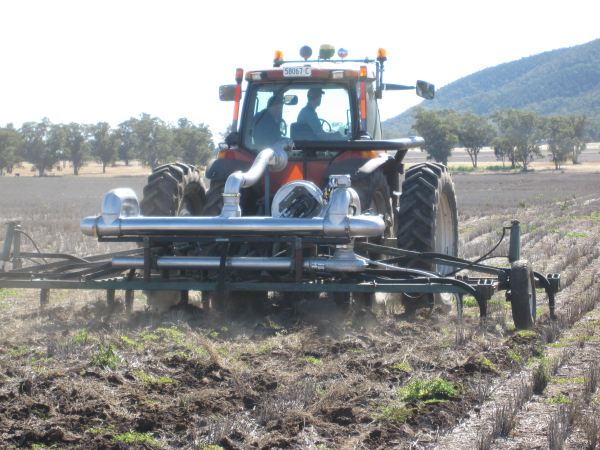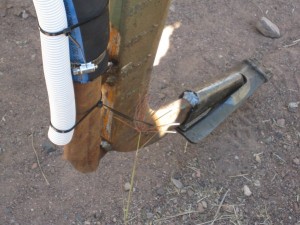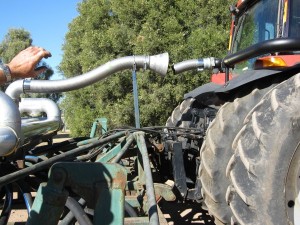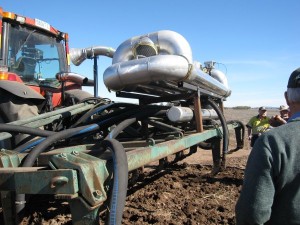If we can omit a negative from our farm businesses, then this is a good thing, but if we can turn that negative into a positive, then even better still! This has been the experience of growers who have taken tractor exhaust emissions are directed them into the soil.
Three negatives are eliminated:
- The release of carbon into the atmosphere
- The use of certain artificial fertilisers that can harm beneficial soil microbes, leach into waterways and aquifers and create mineral imbalance in the plant.
- The use of fungicides as seed treatments – which can also harm beneficial fungi in the soil.
The exhaust emissions become a desirable thing – as they stimulate soil biology, fumigate planting seed and provide carbon and micronutrients to the soil. The emissions are not designed to be a plant fertiliser in themselves, but rather are there to prime the soil microbiology, so that THEY can make available the necessary nutrients for the crop or pasture.
When I write my blogs I like to take practices or techniques rather than branded products, but in this case the information that I will draw from relates to the Bio-Agtive Emissions Technology, which is produced by N/C Quest Inc of Canada. There is a product with a similar concept put out by by Stubble Cruncher in Australia and I know of at least one grower’s home-made rig, but there is more trial data accompanying the BioAgtive system – so my comments relate to this system. The concept behind them however, is similar. I have spoken with Gary Lewis of Quest a number of times, and he is very versed in the science of soils and the associated biology, and hence has a good resource from which to draw. There has also been several independent entities do trial work with the Bio-Agtive Emissions Technology.
What are the nuts and bolts of the system?
Exhaust emissions leave the tractor and are directed into the soil via regular sowing or working tynes or discs. The exhaust emissions leave the tractor exhaust and travel to a condenser which cools the emissions. The emissions can then pass safely down tubes to enter the ground at the tyne (pictured here on a 15 tyned ripper), or enter the seed box of a planter.
The system can be fitted to a soil tilling or planting implement. The condenser unit can be fitted so that it can be lifted off and placed on to different implements – tilling or planting implements, summer or winter planters.
With a tilling implement, the emissions go straight into the ground from the condenser. In the case of a planter, the emissions are directed off into the seed cart, where they fumigate the seed. Growers with the systems mounted on their tractors are encouraged to avoid using fungicidal seed treatments, but rather rely on the exhaust fumigation of the seed, while maintaining any beneficial soil fungi through the elimination of the seed fungicide from the system.
The gases leave the tractor exhaust extremely hot (250oC plus) but are cooled to below 80oC, (ideally to ambient air temperature) and are then directed into the seed cart. The temperature to which they are able to be cooled will depend on things like daytime temperature and the load of the tractor. There are sensors where the emissions leave the condenser which track the temperature. You can also see in the above picture, there is an extra white tubing behind the distribution hose (which is behind the tyne). This senses gas levels, so if any gases are escaping from the soil it will be picked up. The reason that this would happen would be if the emissions were not being cooled adequately. When the emissions are cooled, they become heavier and sink – helping them to absorb and remain in the soil. There are also other adjustments around seeder fan speeds and the ratio of air:emissions that can be altered to optimise the carbon that is captured and absorbed into the soil.
Priming Soil Biology
You will know from my previous posts that soil microbes feed on carbon in the soil as a food source. The carbon dioxide and carbon monoxide contained in the exhaust fumes that are placed in the soil, provide a source on which soil bacteria and fungi can feed and multiply. In the absence of readily available nutrients from synthetic fertilisers, the plants produce root exudates to feed this soil biology, which in turn make nutrients from the soil available to the plant. Once up and going this cycle is self-generating, via energy from the sun and CO2 from the air and via nutrients made available to the plants by the soil microbiology. The emissions are the stimulus for starting this cycle.
Scientist Jill Clapperton stated in her conclusion report of the Bio-Agtive System, “The results show that putting exhaust emissions onto the seed and into the soil does affect the soil microbiology”1. She suggests that “It is most likely that the Bio-Agtive Emissions Technology primes the soil microbiology. Nitrogen Monoxide in nanogram quantities can stimulate the metabolism of ammonia oxidizing bacteria, and act as an antibiotic, to many plant pathogens.”2
As a fumigant
As mentioned above, when planting with exhaust emissions, the gases are directed into the seed cart of the planter where the seed is fumigated. With the cooling of the exhaust gases, they become cool enough that they do not damage the seed, yet warm enough that they do not condense. The humidity created in the box from the gases reportedly create the first steps toward germination, with enzymatic changes in the seed beginning.
Trials by Jill Clapperton in her PhD on the effect of the seed fumigation concluded that “overall, the number of growing bacteria and fungi are significantly less on seed treated with exhaust emissions compared with the same seed that was not.”3 There has also been increased germination rates reported from treated seed.
What is in the Exhaust Gases?
Montana State University (MSU) identified what was present in diesel engine exhaust gases. These were the following4.
|
Oxides of Nitrogen |
Ethene |
|
Water |
Ethane |
|
Carbon dioxide |
Aromatics |
|
Carbon monoxide |
Methane |
|
Oxygen |
Propane |
|
Total hydrocarbon |
Formaldehyde |
|
Nitrogen monoxide |
Sulfur Dioxide |
|
Nitrogen dioxide |
Carbonyl sulphide |
|
Nitrous oxide |
Octane |
|
Ammonia |
Isocyanic Acid |
|
Propene |
Cyanide |
|
Butadiene |
Formic Aid |
|
Ethyne |
Soot |
“Elements such as C,N, O, H, S and P are required in gram quantities; K, Ca, Mg, Fe are required in milligram quantities, and Mn, Zn, Co, Ni, Mo, Cu are required in microgram to nanogram quantities in a litre of soil solution to stimulate the growth of soil bacteria.”5 The analysis of the emissions suggest that is it possible for the micro and nano gram quantities of these cations to be provided by the exhaust emissions.
It was suggested by those that conducted at trial at MSU-Northern that minor emissions such as sulphur dioxide and formic acid are likely to be present, and these may be acting as a biocide for seed borne pathogens.6
Having tested the make-up of the exhaust emissions, MSU then went on to test the effect of the emissions in the field – to see if it was possible to supply essential micronutrients in the fuel exhaust via the fumigated seed to the crops and what effects it would have on the crops and soil.
Yield effects of Exhaust Emissions
Independent yield trials were undertaken in Montana USA7, looking at wheat, oats and yellow split/dry peas. There were 4 treatments of a control, exhaust only, fertiliser only and a combination of fertiliser and exhaust, with 3 replicates of each. Results differed between crops (with the peas having a lot of variation between replicates – a reflection of the sites), and were as follows:
- Peas – no significant difference between any of the treatments.
- Oats – exhaust was significantly greater than the control and the combined fertiliser and exhaust, but no difference to the fertiliser only.
- Wheat – There was a significant yield advantage of the exhaust only and fertiliser only treatments over the control treatment, but with no difference between the exhaust only and fertiliser only treatments.
If all that is achieved by using exhaust emissions is that crop yield is maintained, but whilst also eliminating fertiliser use and costs, then farmers will be well ahead financially. Now the above is just one trial and is a respresentation of just one soil type.
Theory would tell us that such a system should improve with time, as soil microbiology is given an opportunity to increase in the absence of artificial fertiliser applications. There will however be variables that influence this rate of improvement – such as the presence or absence of growing root systems, monocultures versus polycultures etc.
The Lower Murray Darling CMA carried out a replicated trial on wheat in Australia in 2011 with 4 treatments:
- Control
- Emissions only
- Fertiliser only
- Emissions and Fertiliser
The trial concluded that “the injection of exhaust did not improve or compromise crop production relative to the control”.8 There was also no difference in yield to the fertiliser treatment. There was a small but significant increase in protein with the fertiliser only treatment. It would be nice to see such trials replicated over a number of years. When we aim at changing soil microbiology and other soil structural attributes, there needs to be a little bit of patience. We are aiming at turning around a system and soil that, in most cases, has been mistreated for many years.
Again however, if the results from this Mallee trial were sustained over a number of years– there would be considerable cost savings for growers, and increased profitability. The season during this trial was not conducive to high yields. This is when such a system can be valuable. To not output large amounts of money on upfront fertiliser costs is a big advantage – especially in our increasingly unreliable seasons.
Soil Properties
Back to the trials from the U.S., micronutrient analysis of soils (pre sowing and post harvest) and plant tissues, as well as grain nutrient and protein tests were taken out by MSU-Northern.
Soil nitrogen and phosphorus were the most influenced of all the soil tests, tissue tests, grain nutrient tests and protein yield results. Available soil phosphorus increased 15ppm from 17 to 32 ppm P in plots treated with the exhaust emissions, while the control increased just 10ppm. Nitrate nitrogen increased 7.8ppm (from 5 to 12.8ppm) after a crop was grown with exhaust emissions, a significantly greater increase than the control, which increased just 3.7ppm.
These soil property changes are supported by tests on the microbial activity in the soil, before emissions, directly after emissions and after the harvest of the crop. Increased rates of free living nitrogen bacteria were reported, as well as biocidal effects. There were also differences in fuel types, with regular diesel resulting in greater nitrogen fixing bacteria levels than biodiesel. This analysis of soil microbiology supports the above soil tests that reveal increased soil nitrogen rates.
These trials however are just from one season and I would like to see some trial work comparing soils that have had exhaust treatment for some years, versus an untreated area. This would give us a better idea of what influences the exhaust gases may be having on soil properties, and more particularly structural effects on soil.
I look forward to speaking to a few growers who are using the Bio-Agtive Exhaust Emissions Technology, to get their stories on how it has affected their farming operations, profitability and soil properties, including any challenges they may have come up against. I know there are many reports from growers of observational improvements in soil structure, and examples of the neighbours of those owning the system, going on to purchase them. I will report back to you on some growers’ experiences in a few weeks time.
References
1&2,3. Clapperton, J. Report to Montana state University Northern Bio-Energy Centre and N/C Quest – Final Report: Experiments and Results performed by Earthspirit Consulting.
4 Montana State University Bio-Energy Centre. 2012 Final Report. http://www.bioagtive.com/?s=1&p=1072&op=141 19th Sept, 2014.
5 Executive Summary. 2012. Bio-Agtive Emissions Technology Final Report Spring 2012. Pg i
6 6&9 Emissions Testing at MSW-Northern. 2012. BioAgtive Technology Emissions Technology Final Report Spring 2012. Pg 15
7 Clapperton, J. (2009). 2009 Research Summary. Bio-Agtive Emissions technology Final Report Spring 2012. Pg68.
8 The Impacts of tractor exhaust injection on wheat growth and yield in Western New South Wales. Malley Sustainable Farming, 2010. http://www.malleecma.vic.gov.au/resources/reports/soilhealth1112_final.pdf 19th Sept 2014.




